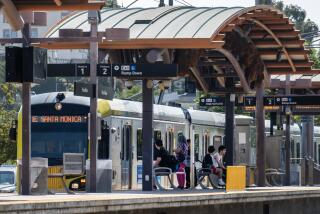Riordan Urges Transit Workers Not to Strike
- Share via
If MTA bus drivers go on strike Friday, more than 16,000 students in the Los Angeles Unified School District will have to find their own transportation to school.
Students will be hitching rides with friends or parents. They will be riding bikes. Or walking. Or simply playing hooky.
“We don’t have to come to school,” Mario Molina, a ninth-grader at Belmont High School near downtown, said as he piled into an MTA bus with dozens of students. “I’ll just tell my mom the buses aren’t passing and she’ll let me stay home.”
District officials say that they don’t have extra buses or the drivers to pick up students stranded by a strike. The district’s own buses already transport about 65,000 students--primarily to ease overcrowding at some campuses and to ferry students to magnet programs. The district does not provide transportation for students like Molina who attend neighborhood schools.
“It’s a logistical problem,” said Alan Tomiyama, the district’s business manager. “In terms of assisting students because of a strike, that is going to be very difficult.”
Tomiyama and other district officials said that Friday would be the worst day of the week for a strike to hit. Friday is football night, and district buses will be doubly busy in the afternoon shuttling football teams, bands, pep squads and others throughout the district.
“Friday during football season is always a challenge for us,” said Enrique Boull’t , deputy director of the district’s transportation branch.
The district’s estimate of the number of stranded students is a conservative one. It accounts for only the 16,000 whose monthly MTA passes are covered by the district because the students attend specialized programs such as continuation schools.
An undetermined number of other students--known as “trippers”--voluntarily take MTA buses to their neighborhood schools and pay their own way, about $20 a month. At Belmont High School on Friday, more than 100 students were seen boarding a stream of buses on 3rd Street.
Los Angeles students are not the only ones who would be affected by the anticipated strike. MTA officials said thousands of students in other parts of the county will have to find alternative transportation if there is a strike. The MTA estimates that at least 6,000 college and vocational students rely on public transit.
News of an impending strike surprised most students. Some greeted the prospect with cheers, seeing an excuse to take a long weekend.
Others said they were afraid to walk to school through unfamiliar neighborhoods where they might be threatened by gang members.
“I don’t know what I’m going to do,” said Donny Gonzales, 17, as he waited outside Poly High School in Sun Valley for his bus to take him home to North Hollywood. “I don’t feel like I can do anything. It’s pretty messed up.”
School Supt. Roy Romer issued a warning to students who were thinking of skipping school.
“If, in fact, the bus strike occurs, I expect our students to be in their classes,” Romer said. “I sympathize with the difficulties they may experience, but it is imperative that they do not let this interfere with continuing their education.”
Many students agreed with Romer, and said they are determined to find alternative transportation--whether riding broken-down bikes or nagging parents to drive them and go to work late.
“I’ll tell my cousin or my uncle or my dad to give me a ride,” said Deborah Ayala, 17, who travels about two miles to school. “I care about my education.”
Adriana Ramirez echoed that sentiment.
The Belmont High senior takes two buses to get to school, a five-mile trip that takes about 40 minutes. No one in her family owns a car. That will leave everyone with one choice: walking.
And so Adriana, 17, plans to wake up hours early Friday, pull her backpack over her shoulders and walk to school.
“It’s my only way to get here,” she said. “I have to walk. That’s my only resource.”
More to Read
Sign up for Essential California
The most important California stories and recommendations in your inbox every morning.
You may occasionally receive promotional content from the Los Angeles Times.













